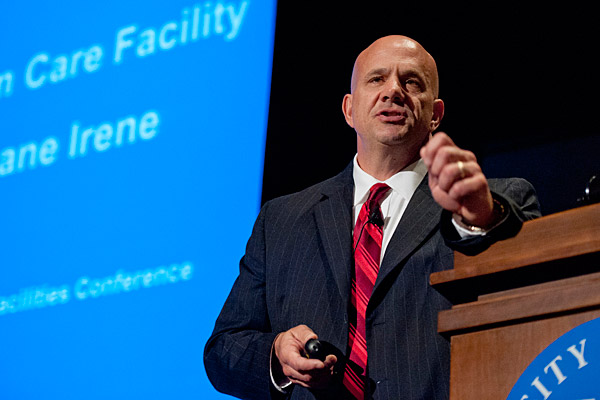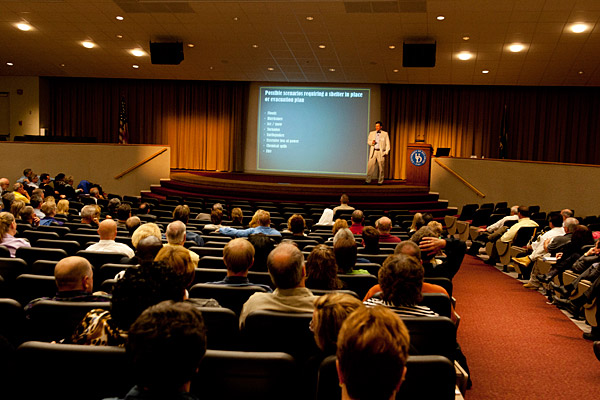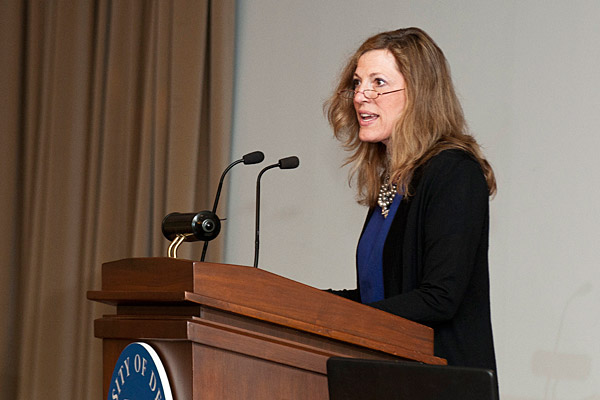


Averting disaster
Conference addresses disaster preparedness for long-term care facilities
4:16 p.m., May 17, 2012--David Weidner’s life changed forever on Sept. 11, 2001, when he watched from across the street as the World Trade Center towers collapsed in New York City. Jody DePriest’s life-changing event was Hurricane Katrina, which roared into New Orleans in the early-morning hours of August 29, 2005.
On Tuesday, May 15, the two disaster management experts joined a large contingent of academic researchers and long-term care facility administrators and employees at the University of Delaware to talk about preparing for the worst—from hurricanes and tornados to bomb threats and chemical spills.
Campus Stories
From graduates, faculty
Doctoral hooding
Weidner and DePriest were guest speakers at the two-day Disaster Preparedness for Long-Term Care Facilities Conference, held at UD’s Clayton Hall.
As director of emergency preparedness for the Health Care Association of New Jersey, Weidner shared experiences from Hurricane Irene. DePriest, who supervises nursing facilities in the New Orleans area, highlighted the Louisiana experience.
Hurricane Irene did not hit the mid-Atlantic coast with the punch expected, while Katrina left incredible devastation in its wake. However, Weidner and DePriest delivered similar messages, with both emphasizing the need to have a detailed plan, train and educate staff, exercise the plan, and modify it as needed after periodic evaluation. Critical elements include equipment, supplies, transportation, communication, and coordination.
And both speakers demonstrated that the devil is in the details—from batteries, flashlights, plywood, meal plans, face cards, keys, and triage tags to generators, fuel, hand-held radios, back-up email systems, maps, cash, and cameras. They emphasized that patient care with frail elders is complicated, and it is best to shelter in place when possible.
“The villain of preparedness is complacency,” said Weidner.
DePriest has had no chance to become complacent. With hurricanes Katrina and Rita in 2005 followed by Gustav and Ike in 2008, DePriest has had more experience with disaster in the past few years than most long-term care facility administrators will have in a lifetime. But that experience has paid off.
“We can now evacuate a 150-bed facility in three to four hours,” he said.
“You may never need this stuff, and I hope you don’t,” he added. “But having it is the best insurance.”
Lessons learned
The conference was convened to share the lessons learned from a statewide research project to develop a crisis response capacity for long-term care facilities during natural and man-made disasters in Delaware. Bethany Hall-Long, professor in the UD School of Nursing, served as principal investigator, and James Kendra, director of the Disaster Research Center (DRC) at UD, was co-investigator of the project for the University.
In welcoming the attendees, Kathleen Matt, dean of the UD College of Health Sciences, and George Watson, dean of the College of Arts and Sciences, both talked about the very successful collaboration across UD and with others in the state that enabled the research to be conducted and the conference to be organized.
“Collaboration is something that happens well in Delaware,” Matt said. “It’s a very small place, a very special place, and a very connected place.”
Watson emphasized that the partnership was yielding “relevant, accessible research that delivers incredible value in bolstering our preparedness.” He referred to the DRC, the oldest such center in the world, as a “robust interdisciplinary center” whose profile of 600 disaster case studies has led to valuable insights in the field.
Rita Landgraf, secretary of the Delaware Department of Health and Social Services (DHSS), also welcomed the attendees, saying, “Collaboration brings cooperation. We need both to ensure that we keep Delaware’s most vulnerable citizens safe during a disaster.”
Research overview
The remainder of the first day’s program included an overview of the research and focus group findings by Kendra; a panel discussion on the role of various state agencies in an evacuation; and a talk by Rick Hong, M.D., a disaster consultant with DHSS, on medical considerations for long-term care facility populations.
Panelists included Ruth Campbell (DSS), Nicole Quinn (Delaware Division of Public Health), Ed Durst and Jamie Turner (Delaware Emergency Management Agency), and Dave Carpenter (New Castle County Office of Emergency Management).
The second day began with the development of an ICS, a standardized on-scene emergency organization designed to aid in the management of resources during incidents.
This was followed by in-depth review of a disaster preparedness plan survey that encompasses an “all-hazards emergency” approach to response. Faculty from the SON and DRC, DRC graduate students, and DEMA planners assisted the long-term care facilitators with their survey plan reviews.
Susan Del Pesco, who is in charge of enforcing state and federal regulations for the protection of individuals in long-term care facilities, catalyzed the academic-research-service partnership and presided over the conference. Del Pesco is director of the Division of Long Term Care Resident Protection of DHSS.
The conference was funded by the Centers for Medicare and Medicaid and the Delaware Division of Public Health. Many state agencies, emergency responders, and health care organizations partnered in planning the event.
About the research project
The project is being conducted through a collaboration among the DHSS Division of Long Term Care Residents Protection, the School of Nursing in the University of Delaware College of Health Sciences, and the Disaster Research Center at UD.
The project was precipitated by two recent events where skilled nursing facilities had to evacuate all residents on short notice. One evacuation was due to a boiler explosion, while the other was in anticipation of flooding associated with Hurricane Irene. Although facilities have formulated disaster plans, an all-hazards approach has not consistently been utilized in those plans; thus, there is a real need for to assess existing tools and develop new ones.
Article by Diane Kukich
Photos by Kathy F. Atkinson and Lane McLaughlin










